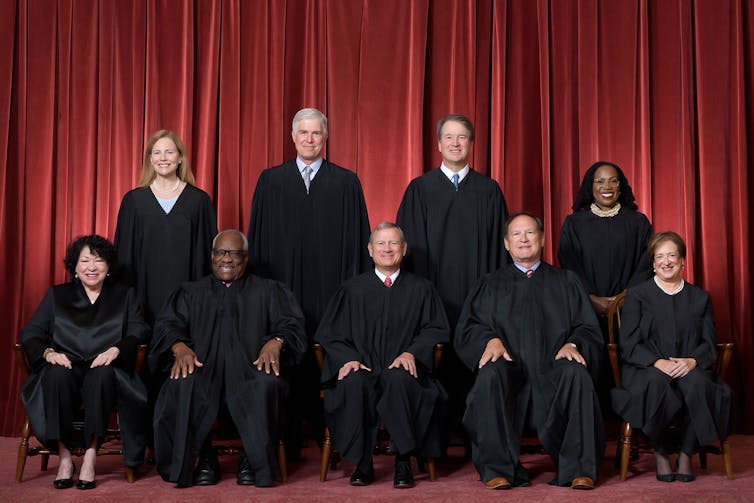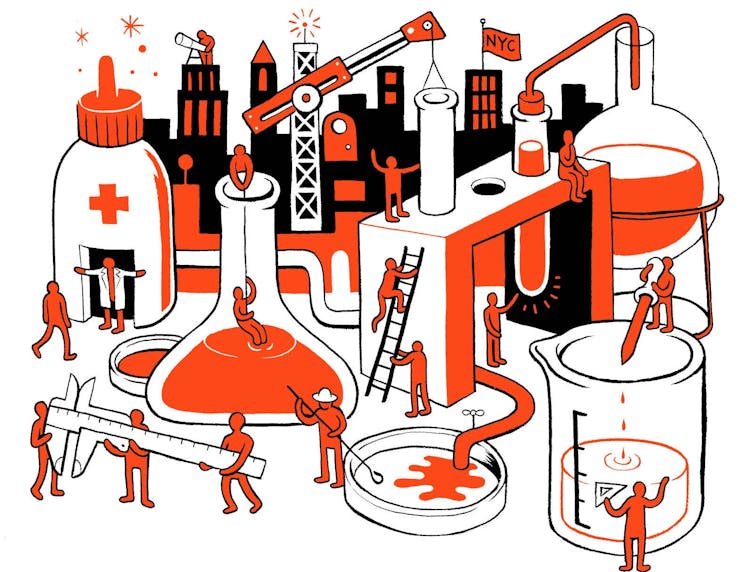
Allyn Cox, via Architect of the Capitol
Victor Menaldo, University of Washington
As Donald Trump’s second inauguration fast approaches, concerns he threatens American democracy are rising yet again. Some warnings have cited Trump’s authoritarian rhetoric, willingness to undermine or malign institutions meant to constrain any president, and a combative style that strives to stretch executive power as far as possible.
Authoritarianism erodes property rights and the rule of law, so financial markets typically respond with alarm to political unrest. If major investors and corporations really believed the United States was on the brink of dictatorship, there would be large-scale capital flight, equity sell-offs, spikes in U.S. credit default swaps or rising bond yields unexplained by typical macroeconomic factors such as inflation forecasts.
Instead, there have been no systematic signs of such market reactions, nor an investor exodus from American markets. Quite the contrary.
This absence of alarm is not conclusive proof that democracy is safe forever, nor that Trump cannot damage American democracy at all. But it does suggest that credible institutions and investors who literally bet on political outcomes for a living do not view an American autocracy as imminent or even likely.
This is probably because the mechanics of upending American democracy would entail surmounting a thick tangle of constitutional, bureaucratic, legal and political obstacles. As a political economist who has written widely about the constitutional foundations of modern democracies, I submit it’s far more complicated than one man issuing brash executive orders.

VCG Wilson/Corbis via Getty Images
Presidents have long seized more power
Throughout American history, presidents have achieved far greater expansions of executive power than Trump did in his first term.
Abraham Lincoln suspended habeas corpus during the Civil War, allowing detention without trial. He bypassed Congress through sweeping executive actions, most notably the Emancipation Proclamation, which declared freedom for enslaved people in Confederate states.
Woodrow Wilson created administrative agencies and imposed draconian censorship during World War I via the Espionage Act of 1917 and the Sedition Act of 1918.
Franklin D. Roosevelt’s court-packing plan failed to pass, but it still cowed the Supreme Court into deference. His New Deal bureaucracy centralized vast powers in the executive branch.
Lyndon B. Johnson obtained the Gulf of Tonkin Resolution, transferring major war-making powers from Congress to the presidency. Richard Nixon invoked executive privilege and ordered secret bombings in Cambodia, steps that largely bypassed congressional oversight.
George W. Bush expanded executive prerogatives after 9/11 with warrantless wiretapping and indefinite detention. Barack Obama faced criticism for the dubious legal rationale behind drone strikes targeting U.S. citizens deemed enemy combatants abroad.
These historical examples should not be conflated with an actual ability to impose one-man rule, though. The United States, whatever its imperfections, has a deeply layered system of checks and balances that has repeatedly stymied presidents of both parties when they tried to govern by decree.
Trump’s openly combative style was in many ways less adept at entrenching presidential power than many of his predecessors. During his first term, he broadcast his intentions so transparently that it galvanized numerous institutional forces – judges, bureaucrats, state officials, inspectors general – to resist his attempts. While Trump’s rhetoric was more incendiary, other presidents achieved deeper expansions of the executive branch more discreetly.

Saul Loeb/POOL/AFP via Getty Images
Trump’s Jan. 6 plan was never realistic
Trump’s failure to impose his will became particularly evident on Jan. 6, 2021, when claims that an “auto-coup” was afoot never translated into the real-world mechanics that would have kept him in office beyond the end of his term.
Even before the Electoral Count Reform Act made the process clearer in 2022, scholars agreed that under the 12th Amendment the vice president’s role in certifying the election is purely ministerial, giving him no constitutional basis to replace or discard certified electoral votes. Similarly, state laws mandate that certification is a mandatory, ministerial duty, preventing officials from arbitrarily refusing to certify election results.
Had Pence refused to certify the Electoral College vote count, it is more likely than not that courts would have swiftly ordered Congress to proceed. Moreover, the 20th Amendment fixed noon on Jan. 20 as the end of the outgoing president’s term, making it impossible for Trump to remain in power just by creating delay or confusion.
The idea that Pence’s refusal to certify could erase state-certified votes, or coerce Congress into accepting alternate slates, had no firm grounding in law or precedent. After Jan. 20, the outgoing president would simply cease to hold office. Thus, the chain of events needed for an auto-coup to occur in 2021 would have fallen apart under the weight of well-established procedures.
A massive bureaucracy
Potential avenues of power consolidation during Trump’s impending second term are equally narrow. The federal bureaucracy makes it exceedingly difficult for a president to rule by fiat.
The Department of Justice alone comprises roughly 115,000 employees, including over 10,000 attorneys and 13,000 FBI agents, most of them career civil servants protected by the Civil Service Reform Act and whistleblower laws. They have their own professional standards and can challenge or reveal political interference. If an administration tries to remove them en masse, it runs into protracted appeals processes, legal constraints, the need to conduct a bevy of lengthy background checks and a crippling loss of institutional knowledge.
Past episodes, including the George W. Bush administration’s politically motivated dismissals of U.S. attorneys in 2006 and 2007, illustrate that congressional oversight and internal department practices can still produce major pushback, resignations and scandals that thwart political interference with the Justice Department.
Independent regulatory agencies also resist being dominated by the president. Many are designed so that no more than three out of five commissioners can belong to the same political party, ensuring some measure of bipartisan representation. Minority commissioners can deploy a host of procedural tools – delaying votes, demanding comprehensive studies, calling for hearings – that slow down or block controversial proposals. This makes it harder for a single leader to unilaterally impose policy. Those minority commissioners can also alert the media and Congress to questionable moves, inviting investigations or public scrutiny.
In addition, a 2024 Supreme Court ruling shifted the power to interpret federal laws, as passed by Congress, away from executive branch government agencies. Now, federal judges play a more active role in determining what Congress’ words mean. This requires agencies to operate within narrower bounds and to produce stronger evidence to justify their decisions. In practical terms, an administration now has less leeway to stretch statutes for partisan or authoritarian ends without encountering judicial pushback.

U.S. Supreme Court
Layers of defenses
American democracy has vulnerabilities, and other democracies have collapsed under powerful executives before. But in my view, it’s not reasonable to draw definitive lessons from a tiny number of extreme outliers, such as Hitler in 1933 or the handful of elected leaders who staged more recent auto-coups in fragile or developing democracies such as Argentina, Peru, Turkey and even Hungary.
The United States stands out for having a complex federal system, entrenched legal practices and multiple layers of institutional friction. Those protections have historically proven adept at limiting presidential overreach – whether subtle or bombastic.
In addition, state-level politicians, including attorneys general and governors, have repeatedly demonstrated their willingness to challenge federal overreach through litigation and noncooperation.
The military’s professional culture of civilian control and constitutional fidelity, consistently upheld by the courts, provides another safeguard. For instance, in 1952 the Supreme Court ruling in Youngstown Sheet and Tube Co. v. Sawyer reversed President Harry Truman’s order that the military seize privately owned steel mills to ensure supply during the Korean War.
All those institutional checks are further buttressed by a robust civil society that can mobilize legal challenges, advocacy campaigns and grassroots resistance. Corporations can wield economic influence through public statements, campaign funding decisions and policy stances – as many did in the aftermath of Jan. 6.
Taken together, these overlapping layers of resistance make the path to autocracy far more challenging than many casual observers might assume. These protections also may explain why most Americans are resigned to Trump’s second term: Many may have come to realize that the nation’s democratic experiment is not at stake – and probably never was.
Victor Menaldo, Professor of Political Science, Co-founder of the Political Economy Forum, University of Washington
This article is republished from The Conversation under a Creative Commons license. Read the original article.






















































